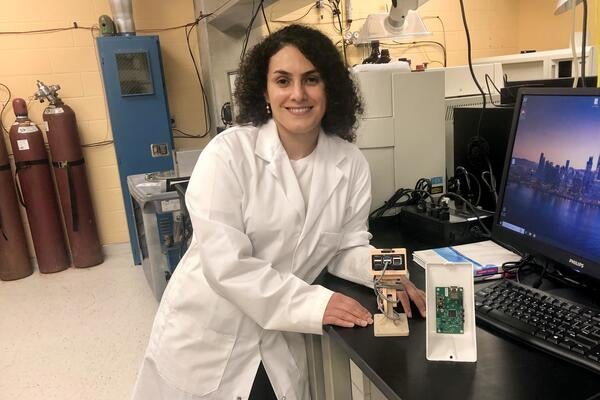
Is your work chair hurting your back?
Study compares traditional versus dynamic chairs during prolonged seated work

Study compares traditional versus dynamic chairs during prolonged seated work
By Media RelationsThose trying to alleviate back pain after long hours of sitting at work may resort to painkillers, massage, acupuncture or heat therapy — but the solution may be as simple as switching out your office chair.
Lower back pain during office work is often attributed to a lack of movement, with experts advising to take regular breaks from sitting as a temporary form of relief.
A new study from University of Waterloo researchers compared dynamic sitting (involving movement) in a backless chair with a rotating seat pan with traditional (inactive or rigid) sitting in a conventional office chair with a backrest and armrest.
Researchers found that compared to sitting in the traditional chair, dynamic sitting increased lower spine movement during computer work activity-guided tasks without negatively impacting posture or evoking pain. Participants completed blocks of regular computer work and activity-guided tasks, such as games that require hip and pelvis movement, while seated.

A traditional office chair (left) and a "dynamic" chair
 "The best posture is a changing posture," said Jessa Davidson, Biomechanics PhD candidate in Waterloo's Department of Kinesiology and Health Sciences and a co-author of the study. "When our participants were performing computer work or playing games in the dynamic chair, we found there were no changes in lower back pain, which was a big positive finding."
"The best posture is a changing posture," said Jessa Davidson, Biomechanics PhD candidate in Waterloo's Department of Kinesiology and Health Sciences and a co-author of the study. "When our participants were performing computer work or playing games in the dynamic chair, we found there were no changes in lower back pain, which was a big positive finding."
With approximately 619 million people living with lower back pain worldwide, there is a growing concern not only with quality of life, but also with productivity and work loss.
Researchers monitored spine movement, pain and work productivity and found no changes in productivity, with participants performing just as well in a moving chair versus a traditional chair.
The dynamic chair offers stability in addition to movement, eliminating many of the risks associated with other forms of dynamic sitting, such as stability balls. It allowed for left, right, front and back tilt and was adjusted to each individual's bodily proportions before use.
A phone was attached to the back of the chair to measure movement or placed in the participant's pocket. Using an app created by the same company that made the chair, the phone provided real-time feedback of the chair's movements to the computer.
Motion capture and tri-axial accelerometers (tilt sensors that calculate measurements simultaneously in three directions ) were used to track the movement of the participants as they completed the various tasks.
This study measured responses from acute exposure to sitting in the dynamic chair, but Davidson would like to see how the chair could be used long-term. As the relationship between sitting, pain, and injury has yet to be fully established, additional evidence is needed to build out further guidelines for using these kinds of chairs.
"Each dynamic chair has different degrees to which it can move and different levels of padding, so there are other designs that can be looked at," Davidson said.
"I'd also like to see dynamic sitting tested on individuals outside of the healthy population, for example with those who have reported concerning levels of pain, to see if it could help to decrease it."
The study, Traditional versus dynamic sitting: Lumbar spine kinematics and pain during computer work and activity guided tasks, was recently published in Applied Ergonomics and co-authored by Davidson, Kinesiology PhD student Jackie Zehr and Drs. Paolo Dominelli and Jack Callaghan.

Read more
15 University of Waterloo researchers have been named to the annual Highly Cited Researchers™ list for significant contributions to their specific fields of research

Read more
Twenty-six researchers receive federal funding to drive discovery, innovation and research infrastructure development

Dr. Hajar Abedi helped refine a prototype radar device developed at the University of Waterloo into a wall-mounted unit now in use to monitor residents of hospitals and long-term care facilities for early signs of health problems. (University of Waterloo)
Read more
New tech from Waterloo researchers allows doctors to detect early signs of health issues by analyzing a patient's walk
The University of Waterloo acknowledges that much of our work takes place on the traditional territory of the Neutral, Anishinaabeg, and Haudenosaunee peoples. Our main campus is situated on the Haldimand Tract, the land granted to the Six Nations that includes six miles on each side of the Grand River. Our active work toward reconciliation takes place across our campuses through research, learning, teaching, and community building, and is co-ordinated within the Office of Indigenous Relations.